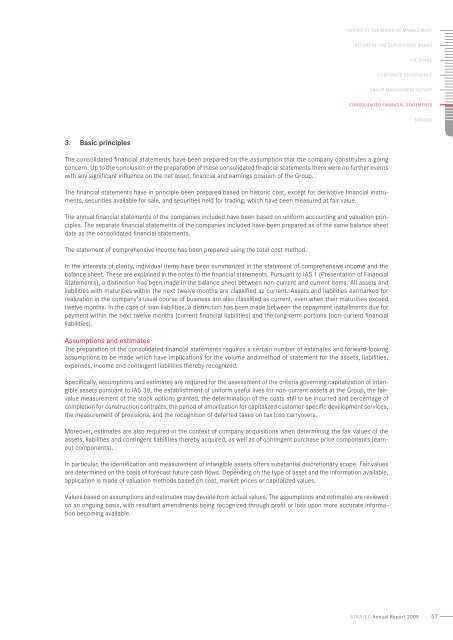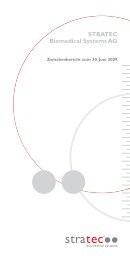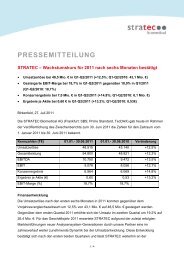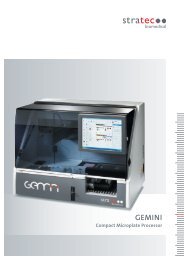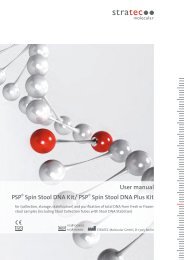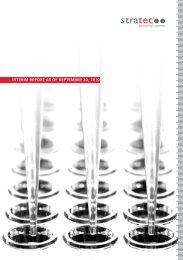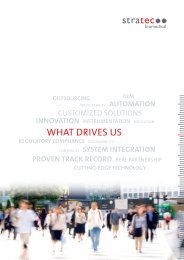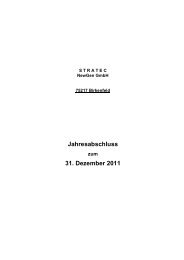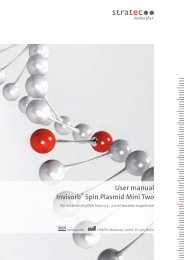annual Report 2009 - STRATEC Biomedical AG
annual Report 2009 - STRATEC Biomedical AG
annual Report 2009 - STRATEC Biomedical AG
Create successful ePaper yourself
Turn your PDF publications into a flip-book with our unique Google optimized e-Paper software.
<strong>Report</strong> of the board of Management<br />
<strong>Report</strong> of the supervisory board<br />
THE share<br />
Corporate Governance<br />
Group Management report<br />
Consolidated financial statements<br />
Service<br />
3. Basic principles<br />
The consolidated financial statements have been prepared on the assumption that the company constitutes a going<br />
concern. Up to the conclusion of the preparation of these consolidated financial statements there were no further events<br />
with any significant influence on the net asset, financial and earnings position of the Group.<br />
The financial statements have in principle been prepared based on historic cost, except for derivative financial instruments,<br />
securities available for sale, and securities held for trading, which have been measured at fair value.<br />
The <strong>annual</strong> financial statements of the companies included have been based on uniform accounting and valuation principles.<br />
The separate financial statements of the companies included have been prepared as of the same balance sheet<br />
date as the consolidated financial statements.<br />
The statement of comprehensive income has been prepared using the total cost method.<br />
In the interests of clarity, individual items have been summarized in the statement of comprehensive income and the<br />
balance sheet. These are explained in the notes to the financial statements. Pursuant to IAS 1 (Presentation of Financial<br />
Statements), a distinction has been made in the balance sheet between non-current and current items. All assets and<br />
liabilities with maturities within the next twelve months are classified as current. Assets and liabilities earmarked for<br />
realization in the company’s usual course of business are also classified as current, even when their maturities exceed<br />
twelve months. In the case of loan liabilities, a distinction has been made between the repayment installments due for<br />
payment within the next twelve months (current financial liabilities) and the long-term portions (non-current financial<br />
liabilities).<br />
Assumptions and estimates<br />
The preparation of the consolidated financial statements requires a certain number of estimates and forward-looking<br />
assumptions to be made which have implications for the volume and method of statement for the assets, liabilities,<br />
expenses, income and contingent liabilities thereby recognized.<br />
Specifically, assumptions and estimates are required for the assessment of the criteria governing capitalization of intangible<br />
assets pursuant to IAS 38, the establishment of uniform useful lives for non-current assets at the Group, the fairvalue<br />
measurement of the stock options granted, the determination of the costs still to be incurred and percentage of<br />
completion for construction contracts, the period of amortization for capitalized customer-specific development services,<br />
the measurement of provisions, and the recognition of deferred taxes on tax loss carryovers.<br />
Moreover, estimates are also required in the context of company acquisitions when determining the fair values of the<br />
assets, liabilities and contingent liabilities thereby acquired, as well as of contingent purchase price components (earnout<br />
components).<br />
In particular, the identification and measurement of intangible assets offers substantial discretionary scope. Fair values<br />
are determined on the basis of forecast future cash flows. Depending on the type of asset and the information available,<br />
application is made of valuation methods based on cost, market prices or capitalized values.<br />
Values based on assumptions and estimates may deviate from actual values. The assumptions and estimates are reviewed<br />
on an ongoing basis, with resultant amendments being recognized through profit or loss upon more accurate information<br />
becoming available.<br />
stratec Annual <strong>Report</strong> <strong>2009</strong><br />
57


